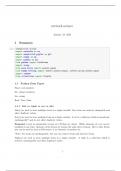Summary
Network Science - Samenvatting + uitwerkingen colleges
- Course
- Institution
Alles wat je moet weten voor het vak Network Science (en Python in het algemeen). Dit bestand bestaat uit zowel een samenvatting als de meest belangrijke concepten (met uitwerkingen) die gehanteerd worden in het vak network science. Het fijne aan dit bestand is dat het uitleg geeft bij de gegeven c...
[Show more]




